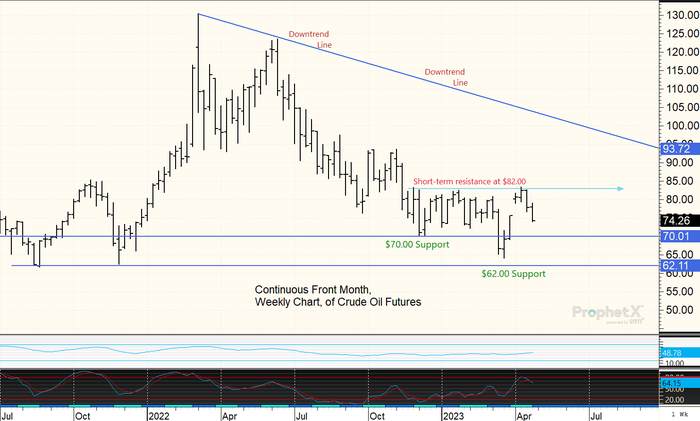
Crude oil futures have traded in a fairly consistent trading range so far for 2023. Fundamentals for the moment seem to be well balanced, keeping prices, for the most part, stable. Nearby futures contracts have mostly stayed in a $12.00 range where $82.00/barrel has been resistance on daily and weekly charts, with $70.00 as price support.
Global supply
Overseas OPEC has cut production, yet Russia still is producing and selling oil to the world at cheaper prices. The European Union and G7 countries had placed price caps on Russian energy with the goal of restricting Russian creation of oil money (Russia would then use to fund the war with Ukraine), yet they did not want to have a supply shock or shortage to global energy markets.
The current sideways trading pattern for crude oil futures very closely matches the timing of when the beginning of the $60 price cap on Russian oil came into effect in December last year.
Filled the gap
After testing $82.00 resistance just weeks ago, prices are now slowly falling lower, potentially to the lower end of that trading range again. Just weeks ago, the crude oil futures market had “gapped open higher” on charts due to news that OPEC announced its million-barrel-a-day production cut. Without any additional bullish news, the market was unable to trade above $82.00 and so crude oil futures have traded lower and filled that gap on the daily and weekly charts.

Demand is solid
This weeks, weekly EIA report showed week-on-week declines in US inventories of gasoline, crude oil, and diesel fuel. According to the report, “implied gasoline demand surged to its highest since late 2021, at 9.5 million barrels a day, bringing the four-week-average to 9.1M bpd”, up nearly 5 percent from last year at this same time. Americans are out and about, and schools not even out yet for summer! What will the summer driving bring? Family vacations and long road trips? For now, demand looks strong.
A newer tool for trading crude oil futures
For farmers, timing and locking in your various fuel and energy needs is paramount for understanding the cost of production for crops on your farm. Regarding fuel, many farmers can book directly with their local coop to book fuel needs, which is a great tool.
Yet, when you desire longer-term opportunities to shift risk, at times, the lack of tools offered by a coop, can often make it difficult for farmers to effectively secure contracts for the duration of time they are looking for. A new contract that looks promising for farmers to shift risk in the energy markets is the micro mini crude oil contract.
The size of this contract is 100 barrels (or approximately 4,200 gallons). This is a newer contract introduced by the exchange over the past year.
Daily trade volume has steadily grown, suggesting this is a viable futures tool farmers can use to hedge energy prices, or speculators can use to attempt to capture trading ranges.
Prior to the micro mini contract, you could use the standard futures contract (1,000 barrels) or the half-sized contracts (500 barrels), called minis.
For many farm producers, the standard contract was too large for their farm needs. Or, because of its size, you may be limited to one purchase (hedge) a year, which can be tricky and stressful, making you really feel that you need to time the purchase absolutely perfectly, because it will reflect the value of fuel for an entire year!
Also limiting to some producers, the margin requirement for this larger 1,000-barrel contract is also substantial, currently near $6,400/contract. The use of the larger contract also incorporates potentially volatile price movements creating the potential for great reward or a hefty margin call.
The micro mini contract in crude oil shows good promise for farmers as a tool to hedge energy prices without having to lock in a contract with a supplier. (Specific contract specifications are available online from the Chicago Mercantile Exchange.)
The micro mini crude oil contract trades each month. Liquidity in any market is important for both entering and exiting. Combined volume and open interest in recent months have been large enough to provide both traders and hedgers confidence to use the newer micro mini crude contract.
With spring planting here, this is time of year when the need for diesel and gas increases, having another tool available to shift risk is important.
Looking at current energy prices, just remember, the longer a market consolidates in a sideways trading pattern, the bigger the price breakout will become at some point down the road. Right now, we are not sure which direction that breakout will ultimately be.
Bullish traders will also argue we may be in store for higher energy prices, due to the ongoing war between Ukraine and Russia, and China lifting COVID restrictions and India buying copious amounts of Russian crude oil.
Bearish traders are insisting a global recession is upon is and the sky is falling.
Have conversations with your vendor to learn the tools they may offer you. In addition, have a conversation with your market advisor on micro mini crude oil contracts – how to use them, and if they will fit your operation’s needs.
Reach Naomi Blohm at 800-334-9779, on Twitter: @naomiblohm, and at [email protected].
Disclaimer: The data contained herein is believed to be drawn from reliable sources but cannot be guaranteed. Individuals acting on this information are responsible for their own actions. Commodity trading may not be suitable for all recipients of this report. Futures and options trading involve significant risk of loss and may not be suitable for everyone. Therefore, carefully consider whether such trading is suitable for you in light of your financial condition. Examples of seasonal price moves or extreme market conditions are not meant to imply that such moves or conditions are common occurrences or likely to occur. Futures prices have already factored in the seasonal aspects of supply and demand. No representation is being made that scenario planning, strategy or discipline will guarantee success or profits. Any decisions you may make to buy, sell or hold a futures or options position on such research are entirely your own and not in any way deemed to be endorsed by or attributed to Total Farm Marketing. Total Farm Marketing and TFM refer to Stewart-Peterson Group Inc., Stewart-Peterson Inc., and SP Risk Services LLC. Stewart-Peterson Group Inc. is registered with the Commodity Futures Trading Commission (CFTC) as an introducing broker and is a member of National Futures Association. SP Risk Services, LLC is an insurance agency and an equal opportunity provider. Stewart-Peterson Inc. is a publishing company. A customer may have relationships with all three companies. SP Risk Services LLC and Stewart-Peterson Inc. are wholly owned by Stewart-Peterson Group Inc. unless otherwise noted, services referenced are services of Stewart-Peterson Group Inc. Presented for solicitation.
The opinions of the author are not necessarily those of Farm Futures or Farm Progress.
About the Author(s)
You May Also Like






